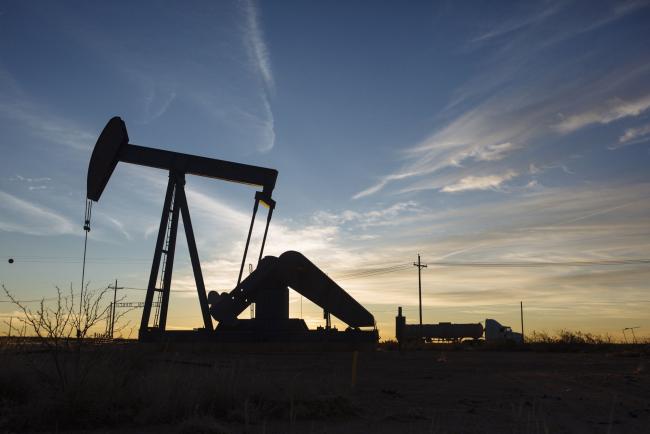(Bloomberg) -- U.S. shale giants stung by billions of dollars in hedging losses are spending big bucks to ditch their positions in a risky bet that prices stay high.
Companies including Pioneer Natural Resources (NYSE:PXD) Co. and EOG Resources Inc (NYSE:EOG). are poised to post historic profits when they report earnings this week. But those windfall earnings would be even higher if it weren’t for massive accounting losses from hedges that protect against falling prices while limiting upside potential. Producers in the aggregate are looking at about $42 billion in oil and gas hedging losses through 2023, according to BloombergNEF calculations of data from last year.
While such a hit won’t necessarily affect their balance sheets — instead representing money left on the table — the sheer scale of the miss has companies spending hundreds of millions of dollars to exit their positions. Hess Corp. in March paid $325 million to exit some of its hedges – more than twice what it cost to enter the contracts six months earlier. Pioneer, which reported $2 billion in hedging losses in 2021, spent $328 million to drop its hedges. And EOG, with $2.8 billion in hedging losses in the first-quarter alone, has paid $85 million.
The moves could pay off big. For Pioneer, dropping the hedges could generate more than $1 billion of additional revenue this year, according to energy researcher Enverus. But it’s also risky. If oil prices fall and producers aren't hedged, they could be left with losses in the billions — and those won't be just on paper. That kind of blowback would likely unravel all the hard work companies have put into earning back investor trust over the last couple of years. And it could bring another rollback to oil production at a time when global markets are incredibly tight.
“My main concern about unwinding hedges is that you had unrealized losses on hedges as prices go higher,” said Matt Marshall, director of market analytics at Aegis Hedging, which advises companies on their hedging strategies. “If you take off those hedges and make them realized losses and then prices come down, then you lose twice.”
Pioneer, which reports first-quarter results Wednesday, declined to comment. EOG, reporting Thursday, didn’t respond to a request for comment.
Producers can lose money on hedges in a couple of ways. Companies using so-called collars to insure against a downturn will buy put options that allow them to sell their oil at a predetermined price. But to fund those puts, they simultaneously sell bullish call options that pay a premium while capping their exposure to higher prices. Those hedging with swaps can incur losses when prices rise above the fixed levels at which they are sold.
Such strategies paid off during the pandemic-driven crash of 2020, but turned painful as recovering economies and Russia’s war in Ukraine lifted energy prices to historic highs. Some producers have capped upside prices at $30 below where oil is currently trading. Laredo Petroleum (NYSE:LPI) Inc. — which capped upside at an average of about $69 for 2022 — had about 73% of its crude output for this year covered by hedges, according to a March investor presentation. Losses, meanwhile, topped $400 million by the end of 2021, according to data from BNEF.
Others like SM Energy Co. and Whiting Petroleum (NYSE:WLL) Corp had racked up losses of more than $500 million from their hedging. And though producers are increasingly moving away from the contracts, half of U.S. shale oil production remains hedged, according to Enverus. Laredo, SM Energy (NYSE:SM) and Whiting didn’t immediately respond to requests for comment.
Unwinding the hedges comes at a price, too. For Diamondback (NASDAQ:FANG), its hedging losses and the $135 million it paid to exit the positions prompted Citi to cut its first-quarter cash flow per share estimate for the company to $7.61 from $8.54, and lower its 2022 CFPS estimate to $31.98 from $32.61. Diamondback didn’t return a request for comment.
Another risk: barrels for delivery in later months are currently trading lower than front-month oil futures, limiting the upside potential for unhedged producers while leaving them open to a future price crash. And though U.S benchmark futures skyrocketed to an eight-year high in March, prices have since dropped as much 27%, whipsawed by war, a pandemic and other, quainter disruptions during one of the most volatile quarters in history.
Still, for much of the industry, the gamble appears to be worth it, with most companies boasting stronger balance sheets that can weather downturns. And some explorers, including Hess (NYSE:HES), have retained downside protections even as they spend millions to remove prices caps, a move CEO John Hess has said would allow the company to benefit from rising oil prices while guarding against a severe price plunge.
“These large companies, their balance sheets are so much cleaner and their risk appetite is higher,” Enverus analyst Andy McConn said. “They’ve recognized the demand from investors for exposure to the near-term prices. And so all those things considered, they’re saying, it’s worth our interest to just get rid of hedges.”
©2022 Bloomberg L.P.
